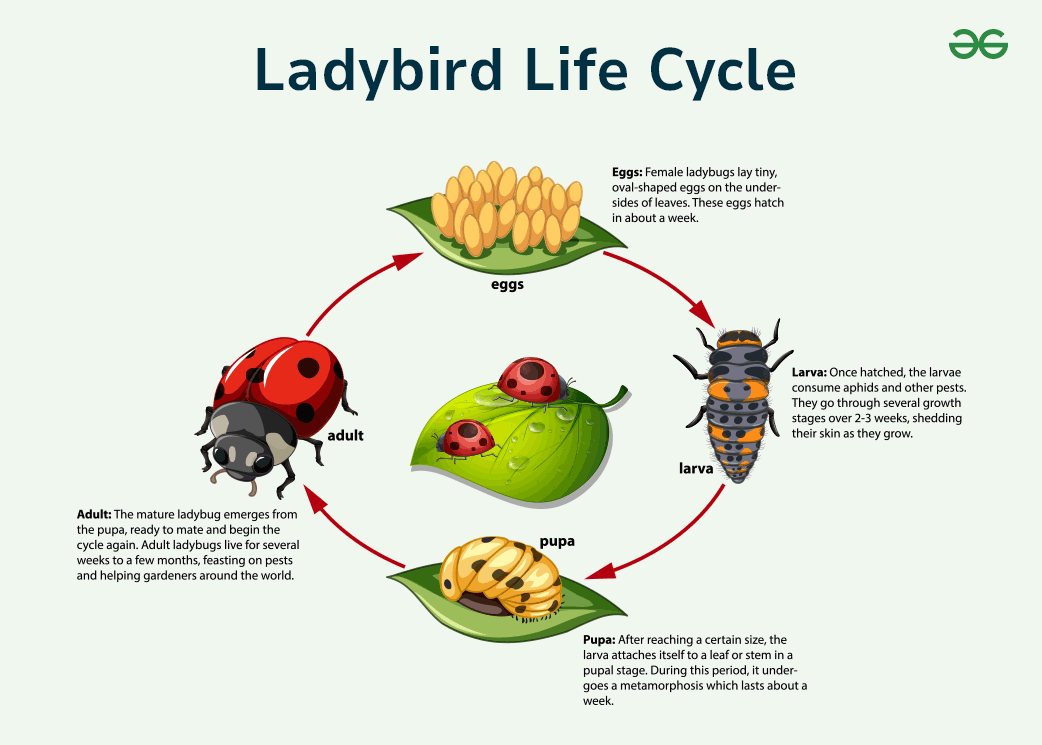
|
|
Ladybird’s Life Cycle helps us to understand the natural process of transformation of this small beetle. The ladybird’s life cycle begins with the egg stage, where tiny eggs are laid on leaves, and continues as these eggs hatch into larvae, which look very different from adult ladybirds. In the pupa stage, the larvae undergo a metamorphosis, eventually emerging as adult ladybirds. This journey from egg to adult is essential for the survival and reproduction of ladybird species. Understanding their life cycle helps us to study their role in nature and their survival strategies. Table of Content About LadybirdLadybird beetles, also known as ladybugs, belong to the phylum Arthropoda, class Insecta, order Coleoptera, and family Coccinellidae. These small, brightly coloured insects are recognized for their characteristic spots and rounded bodies. Ladybird species vary in colour, with some being red, yellow, or even orange. They are known for their feeding habits, primarily preying on aphids and other pests, which makes them beneficial for gardens and crops. Ladybird beetles have a short lifespan, typically living for about a year. They can be used as biological control agents for pests, but can also act as pests or invasive species. Life Cycle of LadybirdThe life cycle of the ladybird beetles shows the following stages;  Ladybird Life Cycle with its Stages Egg StageLadybird beetles begin their life cycle as tiny, oval-shaped eggs. These eggs are usually yellow or orange and are laid in clusters on the underside of leaves or in nooks and corners to protect them from predators and harsh weather. Larva StageAfter a few days, the eggs hatch into larvae. Ladybird larvae look very different from the adults; they are long, black or gray, and often have orange or yellow spots. During this stage, the larvae are active predators, feeding on aphids and other small insects in a very large numbers. Pupa StageOnce the larvae have eaten enough and grown sufficiently, they attach themselves to a leaf or stem and transform into pupae that appears to be yellow or orange with black patterns. Inside the pupa, the ladybird undergoes metamorphosis, changing its body structure to become an adult. This stage lasts for about a week. Adult StageWhen the transformation is complete, the adult ladybird emerges from the pupa. Initially, the new adult is pale and soft, but within a few hours, its exoskeleton hardens, and its bright colors and spots become visible. Adult ladybirds continue the cycle by feeding, reproducing, and laying eggs. General Characteristics of LadybirdsSome of the most common characteristic features of Ladybirds are;
Conclusion – Ladybird Life CycleThe ladybird life cycle is a natural process having four distinct stages: egg, larva, pupa, and adult. Understanding this cycle helps us to understand the essential role ladybird beetles play in controlling pest populations, due to their feeding habits during the larva stage. The transformation from egg to adult is an distinctive example of the process of metamorphosis. By understanding and studying the ladybird life cycle, we can ensure their presence in our gardens and ecosystems, benefiting from their natural pest control abilities.
FAQs – Ladybird Life CycleWhat is the Life Cycle of the Ladybird?
How Long do Ladybirds Live?
What Happens to Ladybirds in Winter?
What Month do Ladybirds Lay Eggs?
What does a Ladybird Eat?
|
Reffered: https://www.geeksforgeeks.org
| School Biology |
Type: | Geek |
Category: | Coding |
Sub Category: | Tutorial |
Uploaded by: | Admin |
Views: | 13 |